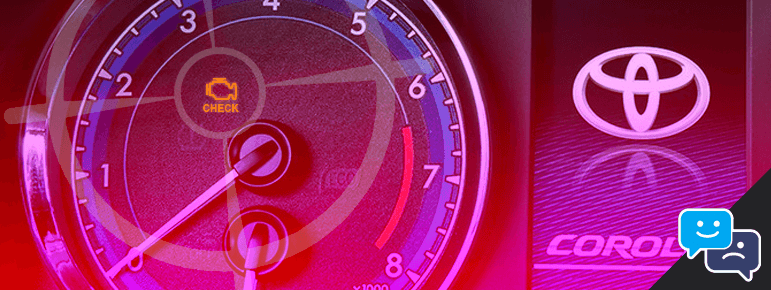Last Updated on April 19, 2024
As you cruise along, relishing the beautiful day, an unwelcome guest appears: the Toyota check engine light illuminates. Uncertainty creeps in, leaving you pondering the potential issue at hand. In the worst-case scenario, a visit to the mechanic might be necessary. However, fret not!
When the Toyota check engine light comes on, it signals a potential problem with the engine or emission control system. A steady glow typically means something less serious, but a flashing check engine light indicates that your vehicle’s engine needs service immediately.
Generally, if the check engine light in your Toyota is a solid illumination, the problem is minor and you can continue to drive.
However, if your check engine light is flashing in your Toyota, it’s recommend not to drive the vehicle and have the dealership or local mechanic look the vehicle over.
Simply put, a flashing check engine light is never a good sign, and indicates a more severe problem with your vehicle’s engine or emissions system.
And in most cases, a flashing check engine light means that the engine is experiencing a misfire, which can potentially cause damage to the catalytic converter.
In this guide, we will explore the meaning of the Toyota check engine light, common symptoms, and tips for troubleshooting.
And by following these simple steps, you should get back behind the wheel in no time.Let’s dive into this!
What Does the Toyota Check Engine Light Mean?
The check engine light, also known as the malfunction indicator lamp (MIL), is a warning that your vehicle’s engine control unit (ECU) has detected potential issues with your fuel system, emissions, or critical components.
This can range from a minor issue like a loose gas cap to a more serious problem like a faulty sensor.
The severity of the check engine light can generally be determined by whether it is a solid illuminated light or a blinking light.
General rule across all major vehicle brands is, a solid illuminated light generally indicates a minor problem, while a blinking light needs to be looked at immediately.
Fact is, your Toyota’s computer is designed to alert you if there’s an issue with your vehicle. Hence, it’s performing its duty by triggering the check engine light.
Common Symptoms of the Toyota Check Engine Light
While an illuminated check engine warning is the most obvious sign something isn’t right with your Toyota, additional symptoms may provide some clues.
One such example is reduced engine performance, a rough idle, excessive fuel consumption, or even unusual noises.
It’s even possible that you may experience multiple symptoms at once. For example, your Toyota might experience acceleration hesitation due to a dirty fuel injector and clogged catalytic convertor.
But in our experience, the most common reason for a Toyota check engine light is due to a loose, missing, or bad gas cap.
Taking note of these symptoms helps when troubleshooting, particularly if the vehicle needs to make a visit to the dealership.
How to Diagnose the Toyota Check Engine Light
If you are feeling in a DIY mood, then there are several steps you can take to troubleshoot that pesky Toyota check engine light.
First, check the gas cap and make sure it is tightly closed. Check to see if it’s loose or screwed on crooked. If so, tighten till you hear three clicks, or remove and screw back on properly.
If it appears the gas cap is broken, then you will need to replace it.
Simply put, a loose or damaged gas cap will allow fuel vapors escape into the air, setting off the check engine light.
Next, check to make sure the air filter is installed correctly, and the air filter assembly is closed and sealed. Believe it or not, a slight leak here will trigger the check engine light.
If everything above checks out, use an OBD-II scanner to read the diagnostic trouble codes (DTCs) stored in the ECU.
A DTC scanner will provide you with information about the specific issue triggering the check engine warning.
Once you have the DTCs, it’s important to research their meanings and possible causes. You can consult online resources, Toyota forums, or seek advice from a mechanic to gain a better understanding of the problem.
And finally, based on the DTCs and your research, you should inspect relevant components such as sensors, electrical connections, hoses, and other related parts to identify any potential issues or malfunctions.
If you don’t have an OBD-II scanner handy, you might be wondering: where can I get one? Head to your local auto parts store. Many of them offer free OBD trouble code scanning, so it won’t cost a thing.
By following these steps, you can effectively troubleshoot the check engine warning in your Toyota yourself.
Common Problems That Trigger the Check Engine Light on a Toyota
Hands down, the most common reason for a check engine light include faulty oxygen sensors, clogged catalytic converters, vacuum leaks, or dirty mass airflow sensor.
Truth is, as the miles on your Toyota start to rack up, emissions components and sensors will begin to collect dirt and grime. An occasional cleaning will often cure any trouble codes associated with these components.
Toyota Check Engine Light is Flashing
A flashing check engine light is never a good sign. Fact is, a flashing engine light indicates a severe issue that requires immediate attention.
It can often indicate a misfire, which can damage the catalytic converter. If you are experiencing a flashing check engine light, drive with caution and try to reduce your speed.
Additionally, avoid sudden and heavy acceleration. Once you can get to your destination, seek professional help promptly.
What Do VSC and Check Engine Lights Mean on a Toyota?
VSC (Vehicle Stability Control) works with the check engine light to alert drivers about potential stability and traction control system issues.
If both lights illuminate simultaneously, have the vehicle inspected for safety.
Trac Off and Check Engine Light on Toyota
When the Trac Off light, accompanied by the check engine light, illuminates, it means the traction control system is disengaged. A malfunctioning sensor or system issue may cause this. Professional inspection is recommended.
Preventive Measures to Avoid Check Engine Light Issues
To reduce the likelihood of check engine light issues, preventive measures are crucial. Regular maintenance and adherence to scheduled service intervals are vital to keep your Toyota running smoothly.
Follow the manufacturer’s recommendations for maintenance tasks such as oil changes, filter replacements, and inspections.
Also, use high-quality fuel and oil, as low-quality products can contribute to engine problems.
Keep the vehicle’s electrical and sensor systems clean by regularly removing dirt and debris. Additionally, monitor your driving habits, avoid aggressive driving, and practice regular vehicle maintenance.
If I Only Reset The Toyota Check Engine Light Will it Come Back On?
Yes, resetting the error code without resolving the reason for the trouble code will only result in the check engine light illuminating once again.
On average, after a check engine light is reset, it takes about 50-100 miles until the warning light to reappear if the problem isn’t resolved.

Can a Toyota Check Engine Light be a Safety Concern?
Yes, a check engine light can sometimes be a safety concern. While a check engine light can be triggered by various reasons, some of them may have a direct impact on the safety. One such example is a problem with the airbag system.
Toyota Engine Warning Light FAQs:
What Should I do if my Check Engine Light is on, But The Car Seems Fine?
If the car appears to be running normally despite the check engine light, it’s advisable to address the issue at your earliest convenience. Use an OBD-II scanner to retrieve DTCs and consult online resources or a mechanic for further guidance.
Can I Drive my Toyota With The Check Engine Light on?
You can drive the vehicle with the a solid illuminated check engine light on, but it’s crucial to address the issue promptly to prevent potential damage and ensure optimal performance.
If however, the check engine light is flashing, avoid driving the vehicle and have a mechanic run a scan of the DTC codes.
How Much Does it Cost to Diagnose And Fix The Check Engine Light in a Toyota?
The cost varies depending on the underlying problem. Diagnosis costs can range from a free scan at an auto parts store to a mechanic’s fee. Repair costs depend on the specific issue and the required parts or labor.
Can a Loose Gas Cap Cause The Check Engine Light to Come on?
Yes, a loose or damaged gas cap is a common cause of the check engine light illuminating. Ensure it is securely tightened or replace it if necessary.
Is it Safe to Ignore The Check Engine Light if The Car Seems Fine?
It’s not recommended to ignore the check engine light, even if the car appears to be running fine. There could still be an underlying issue that needs attention. Addressing it promptly can prevent further complications.
What Are Common Reasons For a Check Engine Light on a Toyota With Over 200,000 Miles?
If you happen to be behind the wheel of a Toyota that has surpassed the 200,000-mile mark and the check engine light suddenly illuminates, there’s no need to panic.
The cause could simply be attributed to a sensor issue. Nonetheless, it’s important to bear in mind that with higher mileage vehicles, there is always an increased likelihood of encountering costly problems.
Problems such as a clogged catalytic converter, a stretched timing chain, or a malfunctioning variable valve timing system caused by years of dirty oil.
If this is the cause of your check engine warning light, have a qualified mechanic thoroughly inspect the vehicle.
Common Toyota Check Engine Light Trouble Codes
Cars can sometimes throw up trouble codes which dictate exactly what the issue is. And if you’ve got a Toyota, these are useful codes to know.
Here’s our list of common ones you might encounter while driving your Toyota:
Here are some common Toyota check engine light trouble codes:
- P0171 – System Too Lean (Bank 1)
- P0420 – Catalyst System Efficiency Below Threshold (Bank 1)
- P0440 – Evaporative Emission Control System Malfunction
- P0441 – Evaporative Emission Control System Incorrect Purge Flow
- P0446 – Evaporative Emission Control System Vent Control Circuit Malfunction
- P0500 – Vehicle Speed Sensor Malfunction
- P1135 – Air/Fuel Ratio Sensor Heater Circuit Malfunction (Bank 1 Sensor 1)
- P1130 – Air/Fuel Ratio Sensor Circuit Range/Performance Malfunction (Bank 1 Sensor 1)
- P1133 – Air/Fuel Ratio Sensor Circuit Response Malfunction (Bank 1 Sensor 1)
- P1150 – Air/Fuel Ratio Sensor Circuit Range/Performance Malfunction (Bank 2 Sensor 1)
- P1153 – Air/Fuel Ratio Sensor Circuit Response Malfunction (Bank 2 Sensor 1)
- P1441 – Secondary Air Injection System Switching Valve No. 2 Stuck Open
- P1444 – Canister Purge Valve Stuck Open
- P2238 – Oxygen Sensor Pumping Current Circuit Low (Bank 1 Sensor 1)
- P2241 – Oxygen Sensor Positive Current Control Circuit Low (Bank 2 Sensor 1)
- P2244 – Oxygen Sensor Reference Voltage Circuit Low (Bank 1 Sensor 1)
- P2247 – Oxygen Sensor Pumping Current Circuit Low (Bank 2 Sensor 1)
- P2251 – Oxygen Sensor Positive Current Control Circuit Low (Bank 1 Sensor 1)
- P2254 – Oxygen Sensor Reference Voltage Circuit Low (Bank 2 Sensor 1)
- P2610 – ECM/PCM Engine Off Timer Performance
While certainty not an exhaustive list, these are the most common DTC codes Toyota drivers often report. There may be other trouble codes specific to different Toyota models and engine configurations, so also keep that in mind.
Final Thoughts
Understanding the Toyota check engine light, its symptoms, and ways to quickly troubleshoot empowers you to handle the situation calmly and confidently.
And often times, the DTC is caused by something as simple as a loose gas cap or dirty O2 sensor. By checking the gas cap, using an OBD-II scanner, researching DTCs, and inspecting relevant components, you can effectively troubleshoot the issue.
Or at the very least, get a general idea of the problem triggering the check engine light. Remember, seeking professional assistance is always advised for complex car problems.
No doubt that Toyota vehicles are engineered to go many trouble free miles, but like any vehicle, preventive maintenance will ensure longevity and optimal performance.
Did we miss anything, or have questions? if so, leave it in the comments section below.

Managing Editor
Christopher is an automotive technical writer. When he’s not at the local autocross event, he can often be found working on one of his cars. Specializes in automotive class action law, industry trends, and automotive maintenance. Email me direct, or learn more about us

